Service Provider Routing and Switching, Professional v1.0
Question 1
Click the Exhibit button.
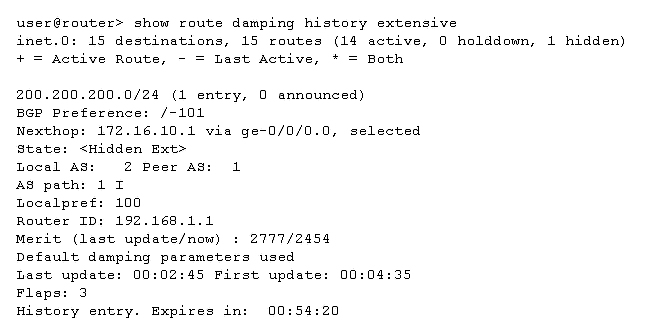
Which two statements are true about the route shown in the exhibit? (Choose two.)
- A. The route is currently active.
- B. The route is currently hidden.
- C. The route has an unreachable next-hop.
- D. The route is currently being damped.
Answer : B
Question 2
The network team will be performing maintenance on R3. The maintenance window requires a reboot of router R3. You want to gracefully move traffic away from
R3 until after the reboot. In this scenario, how would you solve this problem?
- A. Configure the set protocols isis interface all level 1 hold-time 300 parameter, then reboot the router.
- B. Configure the set protocols isis overload parameter, then commit the configuration.
- C. Configure the set protocols isis spf-options delay 300 parameter, then reboot the router.
- D. Configure the set protocols isis interface all level 1 hello-interval 300 parameter, then reboot the router.
Answer : B
Question 3
Click the Exhibit button.
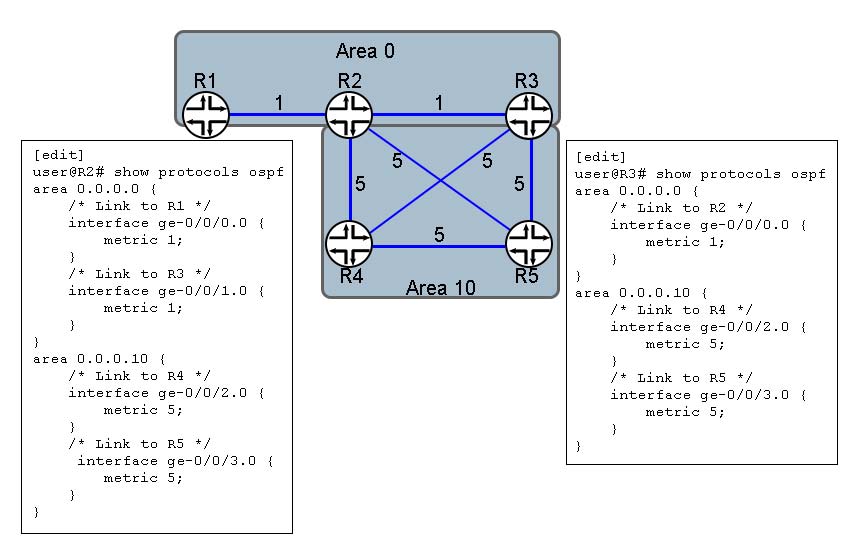
You have the multi-area OSPF network design shown in the exhibit.
Which path will traffic from R1 transit to reach R4 if the R2-R4 link fails?
- A. R1-R2-R5-R3-R4
- B. R1-R2-R3-R5-R4
- C. R1-R2-R3-R4
- D. R1-R2-R5-R4
Answer : D
Question 4
Click the Exhibit button.
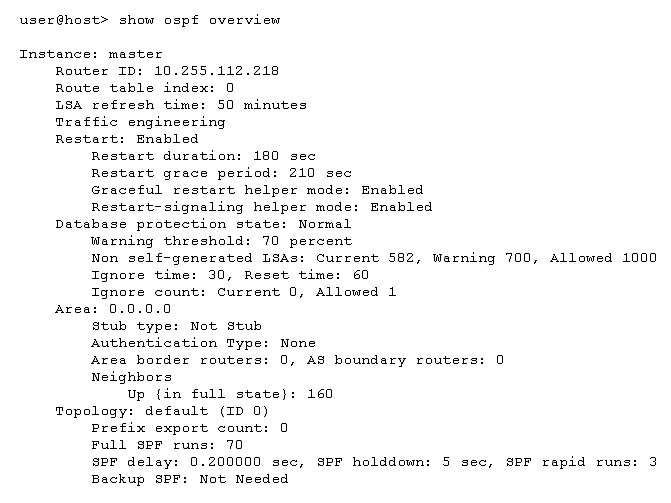
After an acquisition, a customer experiences OSPF flooding during network consolidation and the router is experiencing performance problems. Referring to the exhibit, which OSPF feature set should you add or modify to increase capacity?
- A. traffic engineering
- B. OSPF authentication
- C. Bidirectional Forwarding Detection
- D. database protection
Answer : D
Question 5
Click the Exhibit button.
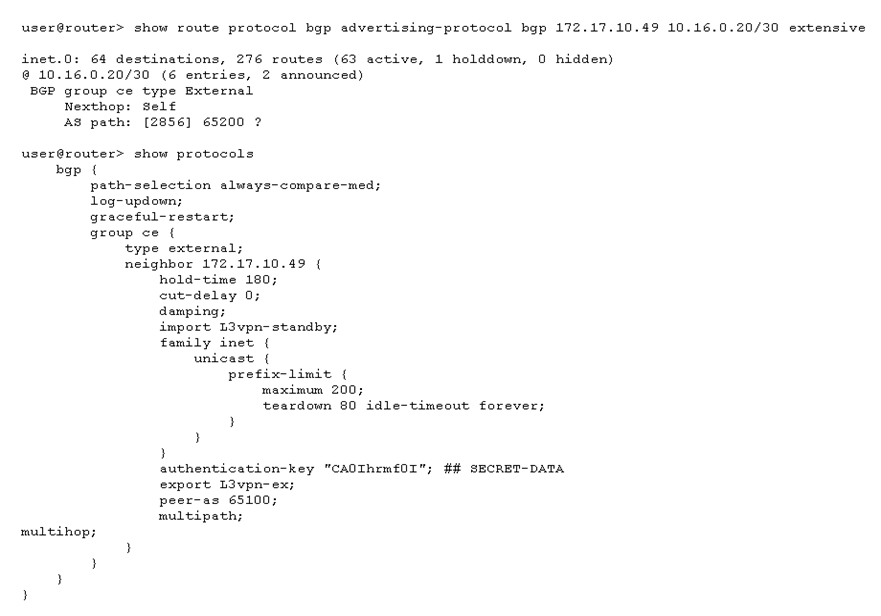
The route shown in the exhibit is being advertised to the EBGP peer and displays a next hop of itself. However, you do not have a next-hop self policy configured.
What would cause this behavior?
- A. The IBGP peers have a next-hop self policy, which the router is exporting to the EBGP neighbors.
- B. The set protocols bgp path-selection as-path-ignore is not set and must be added so the next-hop attribute will propagate from the peer.
- C. The set protocols bgp accept-remote-next hop is not set and must be added so the next-hop attribute will propagate from the peer.
- D. The next-hop attribute was modified by default when it was advertised to the EBGP peer, without applying a policy.
Answer : D
Question 6
Click the Exhibit button.
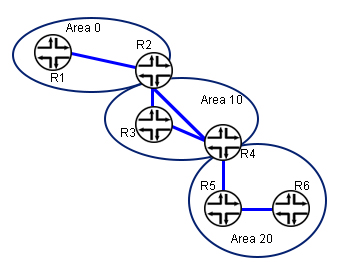
Referring to the exhibit, you want to ensure that routers in Area 20 can connect to routers in Area 0.
Which two steps must be done to allow this behavior? (Choose two.)
- A. A virtual link must be configured under R2 Area 0 and R4 Area 0.
- B. Area 10 must be configured as a stub area.
- C. A virtual link must be configured under R2 Area 0 and R4 Area 20.
- D. Area 10 must be configured as a standard area.
Answer : AD
Question 7
Which two statements are correct regarding site IDs and circuit IDs in a VPLS routing instance? (Choose two.)
- A. In an LDP VPLS routing instance, vpls-id parameters must be different in each location.
- B. In an LDP VPLS routing instance, the vpls-id parameters must match in all locations.
- C. In a BGP VPLS routing instance, the site-id parameters must be different in each location.
- D. In a BGP VPLS routing instance, the site-id parameters must match in all locations.
Answer : BC
Question 8
Click the Exhibit button.
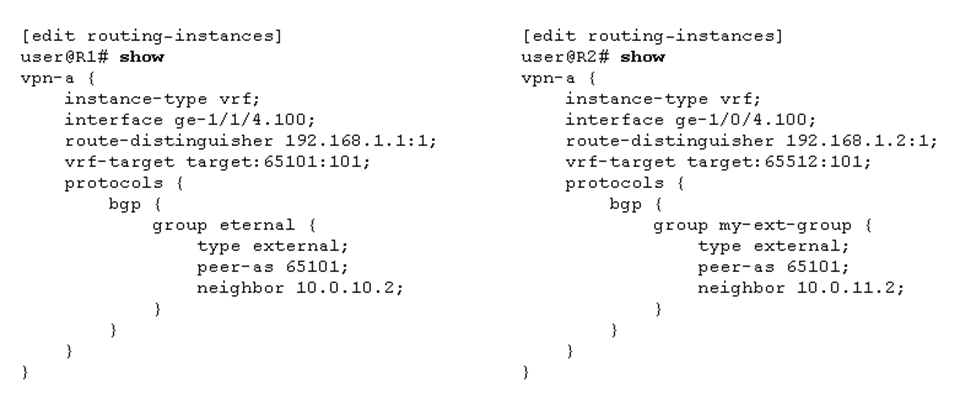
Referring to the exhibit, why are R1 and R2 not exchanging routes between their VPNs?
- A. The route targets are not property configured.
- B. The IP addresses in the BGP configuration must be in the same subnet.
- C. The interfaces unit numbers must be the same on both sides.
- D. The route distinguishers are not properly configured.
Answer : D
Question 9
Click the Exhibit button.
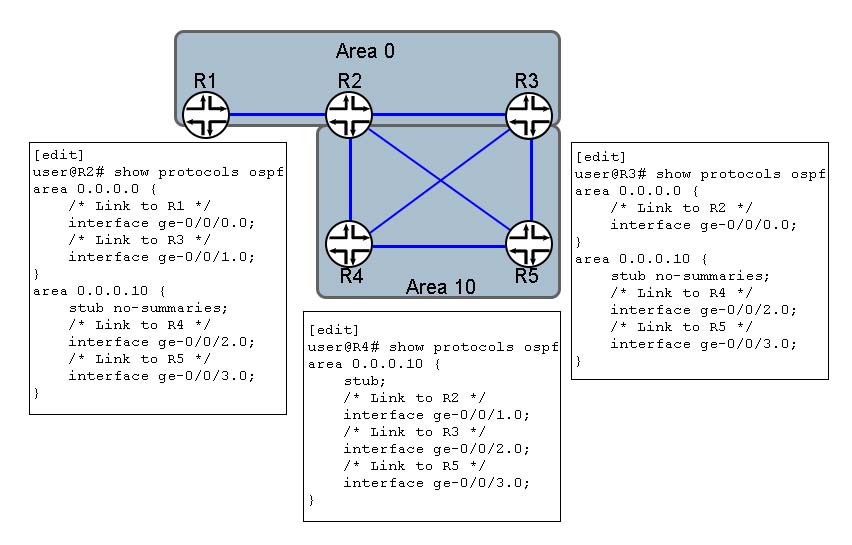
You have configured the OSPF network as shown in the exhibit. However, R4 and R5 do not have connectivity to prefixes outside of Area 10. In this scenario, what will solve this problem?
- A. Configure default-metric on R2 and R3 for Area 10.
- B. Configure no-summaries on R4 for Area 10.
- C. Create a routing policy on R2 and R3 to redistribute Area 0 routes.
- D. Configure the R2-R4 and R3-R4 links as interface-type p2mp.
Answer : A
Reference:
https://www.juniper.net/documentation/en_US/junos/topics/topic-map/ospf-stub-and-not-so-stubby-areas.html
Question 10
Click the Exhibit button.

What are two reasons for the message shown in the exhibit? (Choose two.)
- A. The adjacency is failing because of a misconfigured attribute.
- B. The adjacency is failing because of a faulty TCP connection.
- C. The adjacency is failing because of a misconfigured address.
- D. The adjacency is failing because of an authentication mismatch.
Answer : D
Question 11
You are configuring a BGP-signaled Layer 2 VPN service.
Which two statements are true in this scenario? (Choose two.)
- A. RSVP-signaled LSPs are required.
- B. The family 12vpn auto-discovery-only parameter is required for BGP sessions.
- C. The family 12vpn signaling parameter is required for BGP sessions.
- D. RSVP-signaled or LDP-signaled LSPs may be used.
Answer : CD
Reference:
https://www.juniper.net/documentation/en_US/junos/topics/example/mpls-ex-series-vpn-layer2.html
Question 12
You are troubleshooting a Layer 3 VPN issue. The VPN has been passing traffic successfully for some time, but now it is reported that traffic is no longer flowing.
You look into the bgp.l3vpn.0 table and see newly hidden routes.
What would be the cause of this problem?
- A. The LSP used to connect the PE routers is down.
- B. The connection from the PE to the customer is down.
- C. The BGP routes received from the customer are no longer reachable.
- D. The family inet-vpn parameter was deleted from the BGP configuration of the PE router.
Answer : D
Question 13
Click the Exhibit button.
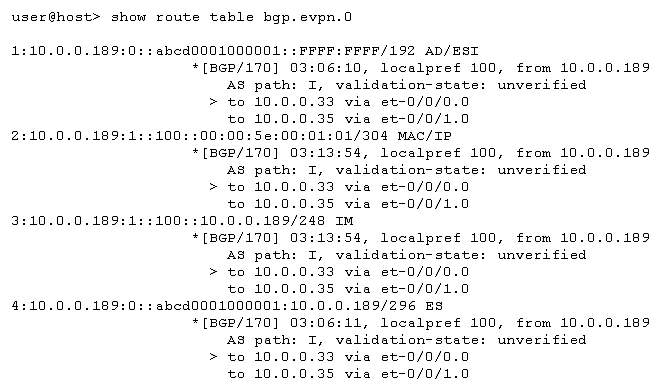
Referring to the exhibit, what is the correct prefix length of the route for the multihomed device?
- A. 192
- B. 304
- C. 296
- D. 248
Answer : B
Reference:
https://www.juniper.net/documentation/en_US/junos/topics/concept/evpn-bgp-multihoming-overview.html
Question 14
Click the Exhibit button.
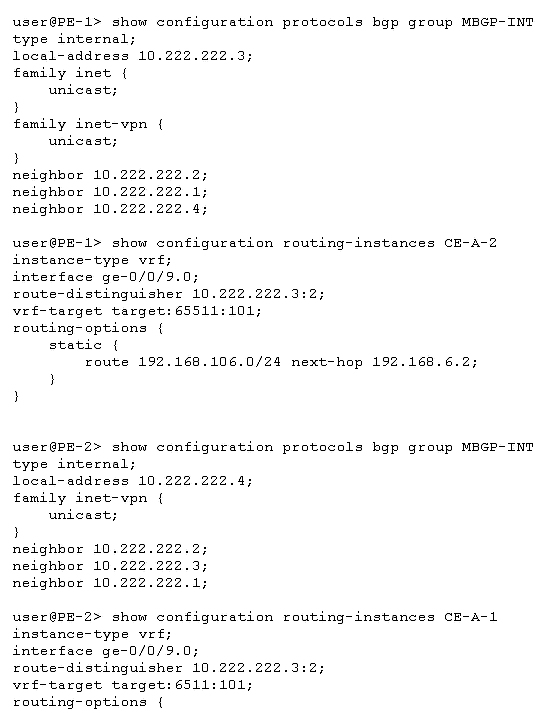
The customer's hosts cannot communicate across their Layer 3 VPN. The exhibit shows the configuration for the two PE devices in the Layer 3 VPN.
What should you do to solve the problem?
- A. Add the family INET unicast NLRI address family in the BGP group for PE-2.
- B. Set the route distinguishers to be different for PE-1 and PE-2.
- C. Add the auto export feature in the routing instances for PE-1.
- D. Set the VRF target to the same value on PE-1 and PE-2.
Answer : D
Question 15
Click the Exhibit button.
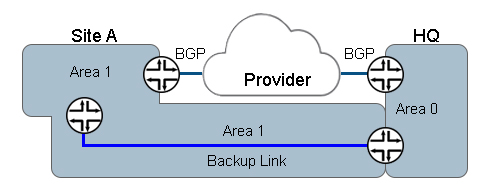
Site HQ connects to Site A through a provider using BGP. The BGP route for Site A destinations is redistributed info OSPF within site HQ. You provision a backup link over a dedicated leased line that connects to Site A, which should only be used when Site A is not reachable through the provider.
When the backup circuit is provisioned, traffic destined to Site A transits the backup link instead of the provider link.
Referring to the exhibit, how do you solve this problem?
- A. Configure the backup link to be in passive mode.
- B. Configure the backup link to be part of Area 0.
- C. Increase the metric on the backup link to Site A.
- D. Change the route preference on OSPF external routes.
Answer : C